
Tigger is a fictional character, an anthropomorphic stuffed tiger. He was originally introduced in the 1928 story collection The House at Pooh Corner, the sequel to the 1926 book Winnie-the-Pooh by A. A. Milne. Like other Pooh characters, Tigger is based on one of Christopher Robin Milne's stuffed toy animals. He appears in the Disney animated versions of Winnie the Pooh and has also appeared in his own film, The Tigger Movie (2000).

Eeyore is a fictional character in the Winnie-the-Pooh books by A. A. Milne. He is generally characterized as a pessimistic, gloomy, depressed, anhedonic, old grey stuffed donkey who is a friend of the title character, Winnie-the-Pooh.

Donald Duck: Goin' Quackers is a platform video game developed and published by Ubi Soft for various consoles and Windows-based personal computers. A different game with the same title was first released for the Game Boy Color, as well as on Game Boy Advance, the latter being given the title Donald Duck Advance.
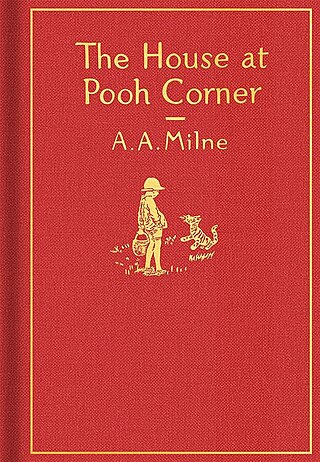
The House at Pooh Corner is a 1928 children's book by A. A. Milne and illustrated by E. H. Shepard. This book is the second novel, and final one by Milne, to feature Winnie-the-Pooh and his world. The book is also notable for introducing the character, Tigger. The book's exact date of publication is unknown beyond the year 1928, but it was likely towards the end of the year as book reviews for the book began appearing during October 1928.

The Many Adventures of Winnie the Pooh is a 1977 American animated musical anthology comedy film produced by Walt Disney Productions and distributed by Buena Vista Distribution. It was first released on a double bill with The Littlest Horse Thieves on March 11, 1977.

Winnie the Pooh and the Blustery Day is a 1968 American animated featurette based on the third, fifth, ninth, and tenth chapters of Winnie-the-Pooh and the second, eighth, and ninth chapters from The House at Pooh Corner by A. A. Milne. The featurette was directed by Wolfgang Reitherman, produced by Walt Disney Productions and released by Buena Vista Distribution Company on December 20, 1968, being shown in theaters with The Horse in the Gray Flannel Suit. This was the second of the studio's Winnie the Pooh theatrical featurettes. It was later added as a segment to the 1977 film The Many Adventures of Winnie the Pooh. The music was written by Richard M. Sherman and Robert B. Sherman. It was notable for being the last Disney animated short to be produced by Walt Disney, who died of lung cancer on December 15, 1966, two years before its release.
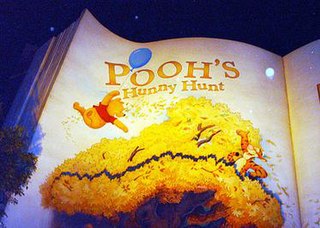
Pooh's Hunny Hunt is a unique trackless dark ride located at Tokyo Disneyland. It is based on the 1977 Disney animated film The Many Adventures of Winnie the Pooh.

Pooh's Grand Adventure: The Search for Christopher Robin is a 1997 American direct-to-video animated adventure comedy-drama film co-written, co-produced, and directed by Karl Geurs. The film follows Pooh and his friends on a journey to find and rescue their friend Christopher Robin from the "skull". Along the way, the group confront their own insecurities throughout the search, facing and conquering them in a series of events where they are forced to act beyond their own known limits, thus discovering their true potential. Unlike the film's predecessors, this film is an entirely original story, not based on any of A. A. Milne's classic stories.

Winnie the Pooh and a Day for Eeyore is a 1983 American animated featurette based on the sixth chapter of both books Winnie-the-Pooh and The House at Pooh Corner by A.A. Milne. Produced by Walt Disney Productions and distributed by Buena Vista Distribution, the short initially received limited release on March 11, 1983, before expanding to a wide release on March 25 as part of a double feature with the re-issue of The Sword in the Stone (1963), which it accompanied in most countries except Australia where it accompanied a reissue of Bedknobs and Broomsticks (1971). Directed by Rick Reinert, the featurette featured the voices of Hal Smith, John Fiedler, Will Ryan, Ralph Wright, and Paul Winchell.
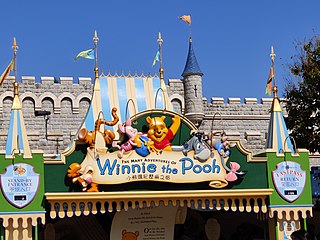
The Many Adventures of Winnie the Pooh is a dark ride based upon the 1977 film of the same name, itself based on the Winnie-the-Pooh books by A. A. Milne. The attraction exists in slightly different forms at the Magic Kingdom in the Walt Disney World Resort, Disneyland, Hong Kong Disneyland, and Shanghai Disneyland Park. Pooh's Hunny Hunt, located in Tokyo Disneyland, is an enhanced "E-ticket class" attraction, featuring full audio animatronics and a trackless ride system.

A Very Merry Pooh Year is a 2002 American direct-to-video Christmas animated musical film produced by Walt Disney Animation (France), S.A. The film features the 1991 Christmas television special Winnie the Pooh and Christmas Too, as well as a new film, Happy Pooh Year. The film animation production was done by Wang Film Productions Co., Ltd., and Sunwoo Animation, (Korea) Co., Ltd.

Winnie the Pooh is a fictional bear and the main character in Disney's Winnie the Pooh franchise, based on the character Winnie-the-Pooh created by English author A. A. Milne and English artist and book illustrator E. H. Shepard, being one of the most popular characters adapted for film and television by The Walt Disney Company. Disney first received certain licensing rights to the Winnie-the-Pooh stories, characters, and trademarks from Stephen Slesinger, Inc. and the estate of A. A. Milne in 1961. Winnie the Pooh is one of the most popular characters adapted for film and one of Disney's most popular characters, especially in terms of merchandising.

Winnie the Pooh and Christmas Too is a 1991 Christmas television special based on the Disney television series The New Adventures of Winnie the Pooh, originally broadcast on December 14, 1991, on ABC and produced by Walt Disney Animation (France), S.A. and Walt Disney Television Animation.
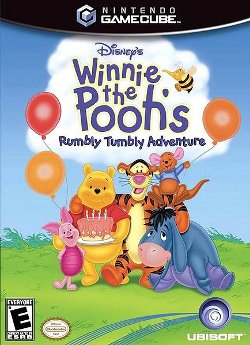
Winnie the Pooh's Rumbly Tumbly Adventure is a 2005 action-adventure game developed by French company Phoenix Studio and co-published by Ubisoft and Disney Interactive. Intended towards younger audiences, the game is based on the Disney version of the Winnie the Pooh character. The game was re-released as a PS2 Classic on the PlayStation Store in 2013.

Winnie-the-Pooh is a fictional anthropomorphic teddy bear created by English author A. A. Milne and English illustrator E. H. Shepard. Winnie-the-Pooh first appeared by name in a children's story commissioned by London's Evening News for Christmas Eve 1925. The character is based on a stuffed toy that Milne had bought for his son Christopher Robin in Harrods department store.
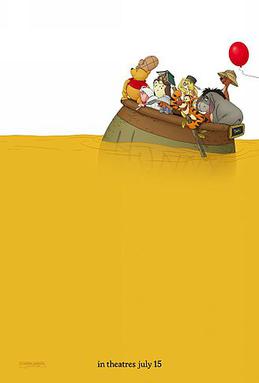
Winnie the Pooh is a 2011 American animated musical comedy film produced by Walt Disney Animation Studios and released by Walt Disney Pictures. It is based on the book series of the same name written by A. A. Milne and illustrated by E. H. Shepard. The film is a revival of Disney's Winnie the Pooh franchise and the fifth theatrical Winnie the Pooh film released, and the second in the Disney Animated Canon. It was directed by Stephen Anderson and Don Hall, and produced by Peter Del Vecho and Clark Spencer, based on a story that Anderson and Hall conceived with Clio Chiang, Don Dougherty, Kendelle Hoyer, Brian Kesinger, Nicole Mitchell, and Jeremy Spears.
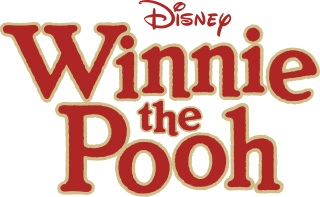
Winnie the Pooh is a media franchise produced by The Walt Disney Company, based on A. A. Milne and E. H. Shepard's stories featuring Winnie-the-Pooh. It started in 1966 with the theatrical release of the short Winnie the Pooh and the Honey Tree.
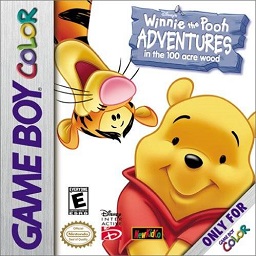
Winnie the Pooh: Adventures in the 100 Acre Wood is an adventure game developed by NewKidCo and TOSE and published by NewKidCo and Disney Interactive. It was released in North America in March 2000 and in Japan on July 7, 2000 for the Game Boy Color.
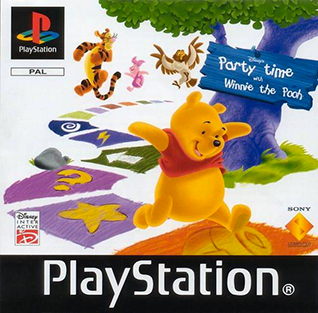
Party Time with Winnie the Pooh is a Party video game released for the PlayStation and Microsoft Windows in 2001. It was developed by Doki Denki Studio and published by Electronic Arts in the United States and Sony Computer Entertainment Europe in Europe.




















